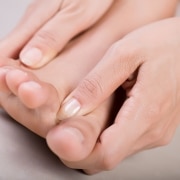It sounds like a bizarre nightmare: you look down and see that one of your toes has turned purple. This may seem like a strange symptom, but, actually, there are a number of reasons your toes can become discolored. If the tips of your feet have taken on a purple hue, Dr. Jeffery LaMour and our team are here to help. Our podiatry practice can assist you with a wide variety of foot-related ailments so you can enjoy excellent health. In the following blog, we explain the common reasons your toe may have turned purple and describe how we can help you return it to its natural color.
It Could be Purple Toe Syndrome
The name of this disorder speaks for itself. Reference defines it: “Purple Toe Syndrome is a medical condition characterized by the blockage of the blood vessels in the foot, which hinders the flow of blood to the tissues.” You may have noticed that other parts of your body take on a bluish purple color when they become too cold, or if you wear tight clothing, which can cut off blood circulation. The same can happen to a toe.
Reference goes on to explain: “the blockage is usually caused by the build-up of cholesterol or by a lump of plaque [a waxy substance consisting of things such as fatty acids, cholesterol, and calcium] becoming lodged in the blood vessels of the foot.” This material can “strangle” parts of your foot, limiting blood flow, destroying cells, and causing the area to become purple “in a process known as cyanosis.” Purple Toe Syndrome is a somewhat serious disorder that “develops suddenly and rapidly and may affect many toes on a foot.” In order to treat this syndrome, you may need to have a stent inserted to facilitate circulation, or, in severe cases, Dr. LaMour may recommend surgery.
Crucial Circulation
One of the primary factors in the color of your skin is your blood flow. While Purple Toe Syndrome is more localized, Livestrong points out that “cold, purple feet signal an abnormality with the arterial circulation, the part of the circulatory system that delivers oxygenated blood from the heart to the body organs and tissues…Peripheral artery disease is the most common culprit for these symptoms.” If your feet are discolored due to PAD (Peripheral Artery Disease), they might also appear pale or white when your circulation is poor, and then become “purplish-red as blood rushes back into the foot.”
PAD can be a serious issue, especially since it can affect your whole body, but “PAD of the lower extremities is a treatable condition—and the sooner, the better.” Particularly if you suffer from diabetes or high cholesterol, come and see Dr. LaMour as soon as you notice a purple color in your feet (which may also be accompanied by a cold feeling). We will assess your feet, recommend appropriate treatment, and refer you to an appropriate specialist if needed.
Blood Blues
While Purple Toe Syndrome and PAD may be the most well known, virtually any disorder that can interfere with blood function can cause your toes to turn purple. Livestrong mentions “Buerger disease… an inflammatory condition that affects small-to-medium sized arteries…inflammation of the involved blood vessels triggers formation of clots that obstruct blood flow.” The website also notes: “Acrocyanosis is another uncommon condition characterized by abnormal regulation of blood vessels.”
Similarly, Heal Treat Cure names “poor blood circulation in your blood” and “anemia or low iron in your body” as potential reasons for purple nail beds. The connection between overall blood flow and purple toes is an excellent reminder that your feet are an important part of your holistic health care. If you notice purple toes, definitely come and see us so we can run diagnostic tests and determine the proper course of treatment.
The Flush of Fungus
A fungal infection could be the root of your purple toe, particularly if the tint is in the toenail. Nice Feet describes: “a fungal nail infection can cause discoloration of fingernails and toenails. Toenail fungus can cause the nail to appear dark.” Fungus can create a whole rainbow of toe colors, including purple, yellow, and green, to name a few. If you have a toenail fungus, Dr. LaMour can help you treat it with our advanced Pinpointe™ FootLaser™ and other excellent options.
Toe Trauma
If you’ve recently banged up your feet, your purple toe could be the result of your injury. Bruises often appear purple, and bleeding beneath the toenail can also cause a darker appearance. Dr. LaMour and our team offer a wide variety of options to assist patients with podiatric injuries.
Is Your Toe Purple?
Have you noticed a purple tint to your toe? Dr. LaMour and our team can help you figure out why your toe has changed its color and help you get the treatment you need to return your natural hue. Contact our Austin podiatry practice today to find out more and schedule your appointment!
Original Source: https://www.drjefflamour.com/foot-diseases/my-toe-is-purple/







